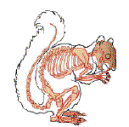 Bert Freed and Dana Andrews in Where the Sidewalk Ends (dir. Otto Preminger, 1950).
Bert Freed and Dana Andrews in Where the Sidewalk Ends (dir. Otto Preminger, 1950).Dana Andrews exudes sourness and fatalism, but with an insolent grace that makes him possibly the quintessential noir leading man. (Am I right in my sudden realization that Steve Martin is primarily channeling Andrews in
Dead Men Don't Wear Plaid, or do they both just have that rubbery shiftless walk and sneer?) In
Where the Sidewalk Ends, Andrews' fallen cop Mark Dixon is so steeped in defeatism and desperation that his performance teeters on the edge of comedy--like when he opens a closet door, revealing to the audience, but not to his partner across the room, the body of the man he has just accidentally killed, saying with attempted nonchalance, "Nothing in there," before shutting the door again. Later, he snarls at a heavy: "I don't like it when rats grin at me."
You could probably count the number of cuts in the film on the teeth of your comb: Preminger and cinematographer Joseph LaShelle glide and linger through nearly each shot, using every inch of screen space to advance the story and explore character. Gene Tierney seems almost too glimmery and frail to exist in the same grimy world that Andrews represents, but they float around together well, like a couple of haunted fashion models (Andrews with his outstanding fedora, and Tierney with about a hundred outfits supplied by her husband Oleg Cassini, who makes a brief appearance as more or less himself). Gary Merrill plays a gangster whom Andrews attempts to frame: his indignation is hard not to sympathize with. Neville Brand, as an assistant goon, throws some wicked punches and seems even to be able to boss his boss around. Ruth Donnelly owns her brief scenes as a wisecracking restaurateur. Karl Malden lends some flair to a thankless role as the good cop with the wrong conviction. And Bert Freed fills his character with more depth and pathos than he has any right to, considering that he doesn't do much more than ride along with Andrews and glare disapprovingly at everything and everyone.














